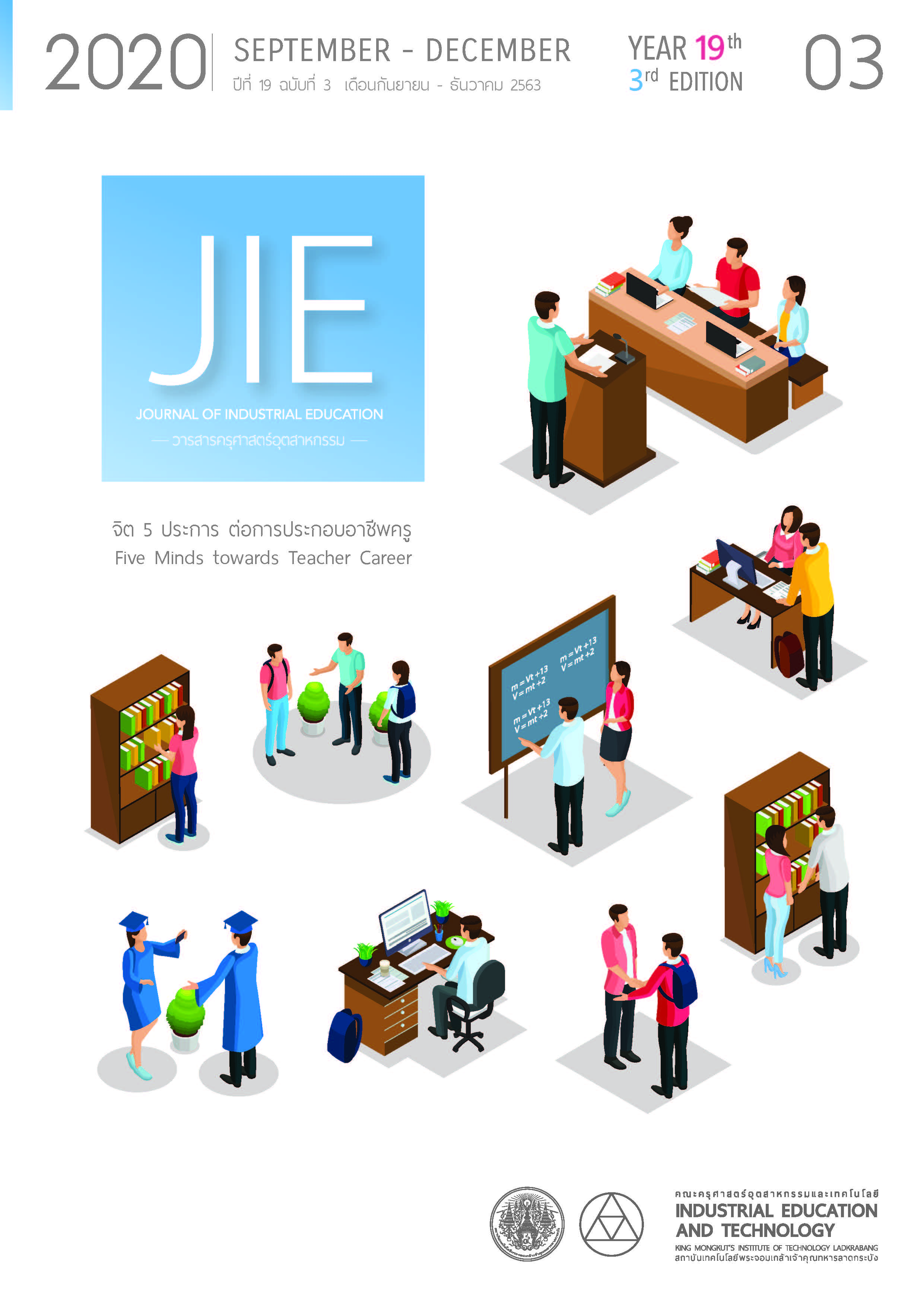การศึกษาการสร้างบ้านพึ่งพาตนเองกรณีศึกษากรุงเทพมหานคร
คำสำคัญ:
บ้านพึ่งพาตนเอง, บ้านพอเพียง, บ้านเกษตรทฤษฎีใหม่, เกษตรในเมืองบทคัดย่อ
งานวิจัยนี้ต้องการสาธิตบ้านพึ่งพาตนเองตามแนวคิดเศรษฐกิจพอเพียงที่สามารถปลูกอยู่ในเมืองซึ่งมีพื้นที่จำกัด และสามารถพิสูจน์ว่านำไปใช้งานได้จริง โดยได้ขอใช้พื้นที่ของมหาวิทยาลัยเกษตรศาสตร์เพื่อปลูกบ้านจากตู้สินค้าที่มีฉนวนกันความร้อน มีการระบายอากาศแบบธรรมชาติเพื่อลดการใช้พลังงาน ใช้วัสดุที่เป็นมิตรต่อสิ่งแวดล้อม และมีระบบผลิตไฟฟ้าพลังงานแสงอาทิตย์ขนาด 1.2 กิโลวัตต์ ต่อเข้ากับระบบไฟฟ้าของการไฟฟ้านครหลวงเพื่อผลิตไฟฟ้าใช้เองบางส่วน มีการปลูกพืชได้แก่ผักสวนครัว เช่น ผักกวางตุ้ง ผักบุ้ง ผักกาดขาว ผักกาดหอม และเห็ดนางฟ้า ไว้เพื่อขายและบริโภค โดยงานวิจัยนี้เก็บข้อมูลเบื้องต้นด้วยการวัดสภาพอากาศ การผลิตไฟฟ้าจากแหล่งพลังงานธรรมชาติ ผ่านการวัดในสถานที่จริง และจากแบบจำลอง รวมถึงการติดตามรายได้จากผลผลิตในบ้าน เพื่อนำไปพัฒนาบ้านต้นแบบพึ่งพาตนเองตามแนวคิดเศรษฐกิจพอเพียง
จากการเก็บข้อมูลพบว่า การผลิตไฟฟ้าจากพลังงานแสงอาทิตย์มีความเพียงพอต่อการใช้ไฟฟ้าในบ้านพึ่งพาตนเอง จึงไม่มีความจำเป็นต้องใช้ไฟฟ้าจากการไฟฟ้านครหลวง รวมทั้งผลผลิตที่ได้จากการแบ่งพื้นที่ทำการเกษตรยังเพียงพอต่อการบริโภค และยังเหลือสำหรับจำหน่ายสร้างรายได้เล็กน้อย อย่างไรก็ตาม อุณหภูมิในอาคารช่วงกลางวันจะมีค่าสูงราว 38oC เนื่องจากไม่มีระบบปรับอากาศ แต่ในเวลากลางคืนอุณหภูมิจะกลับเข้ามาอยู่ในช่วงที่มีสภาวะความน่าสบายที่ 25-27oC และสามารถใช้พัดลมที่ใช้พลังงานจากแบตเตอรี่เพิ่มเติมได้ ดังนั้นจึงสามารถสรุปได้ในเบื้องต้นว่า บ้านพึ่งพาตนเองที่ทำการวิจัยมีความเป็นไปได้ในการสร้างและอยู่อาศัยในบริบทที่พื้นที่จำกัดอย่างในกรุงเทพมหานคร
เอกสารอ้างอิง
Brundtland, G.H., Khalid, M., Agnelli, S., Al-Athel, S. & Chidzero, B.J.N.Y. (1987). Our common future. New York, 8.
Lenssen, N. and Roodman, D.M. (1995). Making better buildings. State of the World, 6.
Oke, T.R., Johnson, G.T., Steyn, D.G. & Watson, I.D. (1991). Simulation of surface urban heat islands under ‘ideal’conditions at night part 2: Diagnosis of causation. Boundary-Layer Meteorology, 56(4), 339-358.
Santamouris, M., Papanikolaou, N., Livada, I., Koronakis, I., Georgakis, C., Argiriou, A. … Assimakopoulos, D.N. (2001). On the impact of urban climate on the energy consumption of buildings. Solar energy, 70(3), 201-216.
Olgyay, V. (2015). Design with climate: bioclimatic approach to architectural regionalism-new and expanded edition. Princeton university press, 14-23.
Zaki, W.M., Nawawi, A.H. & Ahmad, S.S. (2008). Energy savings benefit from passive architecture. Journal of Sustainable Development, Canada Centre of Science and Education, 1(3), 51-63.
Dylewski, R. & Adamczyk, J. (2011). Economic and environmental benefits of thermal insulation of building external walls. Building and Environment, 46(12), 2615-2623.
Marszal, A.J., Heiselberg, P., Bourrelle, J.S., Musall, E., Voss, K., Sartori, I., … Napolitano, A. (2011). Zero Energy Building–A review of definitions and calculation methodologies. Energy and buildings, 43(4), 971-979.
Chaiwat, T., Mai-Ngam, N., Dumchuen, N., Amesbutr, J., Thana, P., … Chaisrilak, C. (2020). Behavioral Economics on Life journey and Collective Action of Thai Household under COVID-19 Situation. Health Systems Research Institute (HSRI). [Online]. Available https://kb.hsri.or.th/dspace/handle/11228/5233 Retrieved Nov 25, 2020. (in Thai)
Chumtakhob, D. (2020). The Sufficiency economy alternatives Survival in the Crisis of Covid-19. Journal of Multidisciplinary Academic Research and Development (JMARD). 2, 3 (Sep. 2020), 11-22. (in Thai)
Panyakaew, S. & Yimproyoon, C. (2015). Professional Practice guideline: The design of electrical system from solar energy for buildings in Thailand. Vol. 1. The Association of Siamese Architects under the Royal Patronage, 1-207. (in Thai)
Rangsiraksa, P. (2006). September. Thermal comfort in Bangkok residential buildings, Thailand. In Proceedings of the PLEA2006 23rd Conference on Passive and Low Energy Architecture, Geneva, Switzerland, 6-8.
Bhikhoo, N., Hashemi, A. & Cruickshank, H. (2017). Improving thermal comfort of low-income housing in Thailand through passive design strategies. Sustainability, 9(8), 1440.
Naipinit, A., Sakolnakorn, T.P.N. & Kroeksakul, P. (2014). Sufficiency economy for social and environmental sustainability: A case study of four villages in rural Thailand. Asian Social Science, 10(2), 102. (in Thai)
ดาวน์โหลด
เผยแพร่แล้ว
รูปแบบการอ้างอิง
ฉบับ
ประเภทบทความ
สัญญาอนุญาต
"ข้อคิดเห็น เนื้อหา รวมทั้งการใช้ภาษาในบทความถือเป็นความรับผิดชอบของผู้เขียน"



